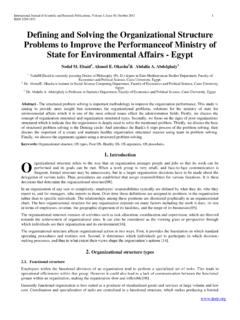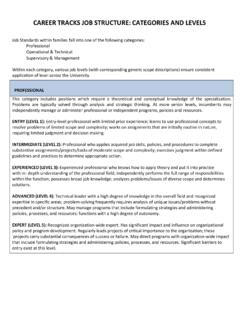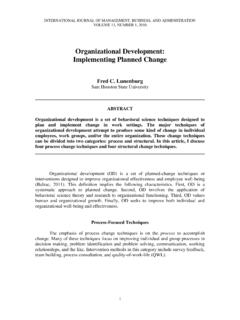Transcription of Management and Leadership Issues for School Building …
1 Management and Leadership Issues for School Building Leaders This manuscript has been peer-reviewed, accepted, and endorsed by the National Council of Professors of Educational Administration (NCPEA) as a significant contribution to the scholarship and practice of School administration and K-12 education. James Tobin The College at Brockport, SUNY School principals are confronted with a variety of Issues as they provide Leadership and organization to their schools. Evidence is growing that successful School leaders influence achievement through the support and development of effective teachers and the implementation of effective organizational practice (Davis, Darling-Hammond, LaPointe, & Meyerson, 2005). On occasion it takes specific Leadership behaviors from the principal to begin to resolve the Issues ; at other times it takes organizational and Management skills.
2 The classroom activity in this instructional module is designed to provide options for an instructor in developing the background knowledge and information to provide Leadership and/or the organizational and Management skills necessary for educational administration candidates to begin developing personal approaches to organizational behavior. Discussions and/or reactions after each presentation provide opportunities to focus attention on establishing a systems perspective for guiding administrative behavior as Issues are clarified and solutions are identified, including anticipated and unanticipated consequences. NCPEA International Journal of Educational Leadership Preparation, Vol. 9, No. 1 March, 2014 ISSN: 2155-9635 2014 National Council of Professors of Educational Administration Background Information Today s School administrators are confronted, on a daily basis, with a variety of Issues from how to implement the new Common Core State Standards (CCSS), to handling irate parents, to supporting overwhelmed teachers.
3 How they react to these Issues , to a great extent, determines their success or failure as School administrators. Building principals are charged with being the instructional and visionary leaders that every community wants and with successfully managing the day-to-day happenings that occur in every School . This is nothing new. When do I engage in Leadership behavior and when am I supposed to manage the enterprise? These are two of the more significant and perplexing Issues confronting today s School administrators especially Building principals. The literature has a wealth of information about these two concepts and yet the message can be quite confusing. Management is concerned primarily with getting the work of the organization completed in an efficient and effective manner.
4 Its focus is typically on the day to day functioning of the organization giving primary attention to getting the job done (Lalonde, 2010). Leadership , on the other hand focuses attention on the future or what needs to be done. Its focus is on vision and empowerment and reaching goals (Lalonde, 2010)). While the manager will direct the workforce to complete the required tasks the most efficient way, the leader tends to inspire or venture into new ways of doing things. Leadership is viewed as an influence process while Management is seen as utilizing control (Catano & Stronge, 2007). The leader seeks to find new solutions to bring about improvement while the manager seeks to assure that all participants remain on task and meet their required goals.
5 The leader is concerned with understanding and changing others beliefs and with changing the status quo. The manager, however, advocates stability and carries out his responsibilities by exercising authority to get the goals accomplished (Lunenburg, 2011). Managers do things right, but leaders do the right things. This phrase has been attributed to both Peter Drucker and to Warren Bennis, both of whom have contributed significantly to the literature on Leadership and Management (Bennis, 1989; Drucker, 1966). It expresses in simple and direct terms the differences in the two functions that administrative or executive personnel engage in. The manager is required to get things done properly, and the leader focuses attention on what really needs to be done.
6 One of the first researchers to examine the differences between Management and Leadership was Abraham Zalenik of Harvard University. In 1977 he published an article in the Harvard Business Review in which he shared his belief that both leaders and managers were important to organizations even though their contributions differed. Managers tend to focus their attention on getting tasks completed in an efficient and effective manner whereas leaders were more focused on trying to understand the people in the organization and to gain their trust. Managers tended to rely on authority to accomplish their tasks whereas leaders tended to utilize persuasion and influence (Zalenik, 1977). In a more recent discussion of Leadership and Management , leaders were described as being more focused on people where the manager was focused on tasks.
7 The leader tends to look outward, in a more expansive way whereas the manager s focus was inward and on the specific task or tasks that needed to be completed. Leaders focused their attention on articulating a vision while the manager was clearly more focused on executing plans (Lunenburg, 2011). It is important to note, however, that Zalenik and Lunenburg believed that both leaders and managers were needed for optimal effectiveness in organizations. All of these distinctions serve to contrast the view that the functions of Management and the functions of Leadership differ from one another. Colin Powell, the former Secretary of State remarked Leadership is the art of accomplishing more than the science of Management says is possible (McGowan & Miller, 2001).
8 There is little doubt that today s School principal, in fact any School administrator, is confronted with an enormous task of trying to not only do the right thing, but to do it the right way. The literature on Leadership and Management in schools also provides varying positions on the roles and duties that Building principals must provide (Lunenburg, 2010; Trail, 2000; Leithwood & Riehl, 2003; Davis, 2005; Marshall, 2008; Mendels, 2012). One thing is certain, however; being an effective Building manager is no longer sufficient. The job expectations for School principals are enormous and compel principals to take on many roles, including the role of teacher, psychologist, social worker, facilities manager, assessment expert, educational visionary, diplomat, mentor, PR director coach, and cheerleader (Trail, 2000; Davis, 2005).
9 This ever increasing variety of roles makes their daily work inherently complex and the demands on them are increasingly fragmented, rapid fire, and voluminous (Lunenburg, 2010). Additionally, the principal s role has been altered by the advent of School or site-based Management which has led to decentralization of control, transferring considerable decision making from district office to individual schools as a way to give principals, teachers and others more authority over what happens in schools (Wohlstetter and Briggs, 1994). All of this makes the roles that Building principals face every day more complex than ever. Today s principals also have a heavy workload and work at a rapid pace that is both hectic and taxing. On average, elementary School principals work fifty-one hours a [and] high School principals average about fifty-three hours a (Lunenburg, 2010).
10 Increasingly, principals are also being pushed (not so gently) into instructional and community Leadership roles. Mendels (2012) believes that today s principals need to be focused on instruction and not Building Management . What s a principal to do? To manage this cacophony of demands requires Building principals to have exceptional oral communication skills. They spend upwards of 70 80% of their time in interpersonal communication, most of which is face-to-face and by telephone. Add to this the volume of daily e-mail communication and their tasks become even more complex (Lunenburg, 2010). Educational leaders must guide their schools through the challenges posed by an increasingly complex environment. Curriculum standards, achievement benchmarks, programmatic requirements and other policy directives from many sources generate complicated and unpredictable requirements for schools.


















